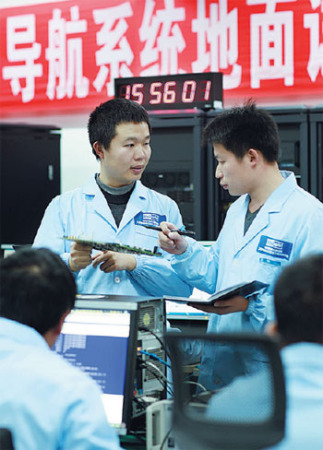
Scientists at the center prepare for the launch of the first satellite of the Beidou global system in January. (Photos provided to China Daily)
Scientist and his 300-strong team have their eyes on global satellite coverage by 2020
For the past 20 years, Wang Feixue and his team have been working on China's Beidou Navigation Satellite System. Now the pace is being stepped up to "lay out the stars" and form a constellation of satellites orbiting the Earth.
On March 30, the Beidou system sent its first satellite into orbit, marking the first stage of its upgrade from a regional service to global coverage by 2020.
Wang, 44, heads the Center for Satellite Navigation and Positioning Technology at the National University of Defense Technology in Changsha, Hunan province. The 300-strong research team, with an average age below 30, conducts most of the Beidou system's research and development.
"The Beidou global system will focus on improving navigation precision and expanding its application in the Asia-Pacific region," Wang said.
"Because the profitable period for the second generation of satellite navigation systems has passed, further industrial breakthroughs will depend on innovation of the application model and progress of the system," he added.
China will launch four more Beidou network satellites and build seven receiving stations nationwide by the end of this year. The system will have 35 satellites, five of them in geostationary orbit, and achieve higher accuracy by being able to focus to within 1.5 meters of a given point rather than the present 10 meters by 2020.
Wang said some of Beidou's unique technological features, such as the short text messaging service, will find greater markets in the Asia-Pacific region. Compared with the expensive satellite phone service, Beidou's text messaging is free of charge and allows users to send up to 60 Chinese characters.
"The short messaging service was planned to be a byproduct, but it has surprisingly become one of Beidou's most popular functions. It not only shows where you are but also lets others know where you are through communication," he said.
Beidou's short message service first attracted public attention during the rescue work after a magnitude-8.0 earthquake in Wenchuan, Sichuan province, in 2008.
"When power was cut off in the disaster area, Beidou still managed to send back signals to guide rescue teams," Wang said.
"It not only illustrated Beidou's powerful functions at a difficult time and in difficult terrain but also reminded people of Beidou's significance as part of China's information infrastructure," he added.
Wang joined the Beidou project in 1995, as a doctoral student at the National University of Defense Technology. At that time, development of the system had stagnated for almost a decade because scientists could not overcome a technological bottleneck on signal acquisition.
Wang sensed that a potential answer to that bottleneck lay in the burgeoning digital technology.
















































